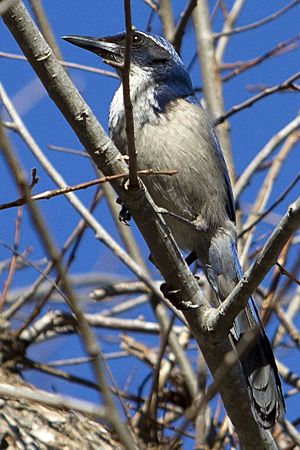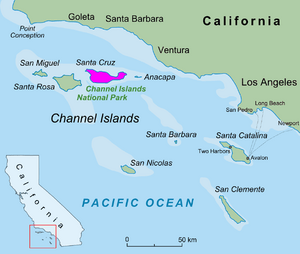Island scrub jay facts for kids
Quick facts for kids Island scrub jay |
|
|---|---|
 |
|
| Conservation status | |
| Scientific classification | |
| Genus: |
Aphelocoma
|
| Species: |
insularis
|
 |
|
|
Year-round resident range on Santa Cruz Island
|
|
The island scrub jay (Aphelocoma insularis) is a special bird found only on Santa Cruz Island in California. It's also called the island jay or Santa Cruz jay. This bird is unique because it's the only land bird species that lives only on one island in the entire U.S. and Canada.
Island scrub jays are related to the California scrub jay found on the mainland. But island jays are bigger, have brighter colors, and a stronger beak. They are very smart! In the fall, they bury acorns to eat later. They also enjoy eating insects, spiders, snakes, lizards, mice, and even eggs and baby birds from other nests.
Contents
About the Island Scrub Jay
A Unique Island Bird
The island scrub jay was first described by a bird expert named Henry Henshaw in 1886. Scientists found old bones of this bird on Santa Cruz Island from the late 1700s. This shows they have lived there for a long time!
Island scrub jays belong to the crow family, which includes crows, ravens, and other jays. They are part of a group called "scrub jays" in North America. These birds were once thought to be one species. Now, scientists know there are four different types: the Florida scrub jay, the island scrub jay, the California scrub jay, and Woodhouse's scrub jay.
Why They Stay on the Island
Island scrub jays seem unable to fly across large areas of water. There is only one old record of an island scrub jay on nearby Santa Rosa Island. This island is only about 10 kilometers (6 miles) away. There are no clear records of them on any other Channel Islands.
Scientists have studied the DNA of these birds. They believe the island scrub jay has been living separately on Santa Cruz Island for about one million years. Long ago, about 11,000 years ago, the four northern Channel Islands were connected as one big island. The jays likely lived on all of them. But as sea levels rose, the islands separated. The jays then disappeared from Santa Rosa, San Miguel, and Anacapa.
Where They Live and What They Eat
The island scrub jay lives only on Santa Cruz Island. This is the largest of California's Channel Islands. The island is a special nature reserve. Part of it is managed by the National Park Service as part of the Channel Islands National Park. The rest is managed by Nature Conservancy.
These jays live in areas with oak trees and bishop pine trees. Jays living in pine areas have slightly different beaks than those in oak areas. This helps them eat the different foods found in each habitat.
The name Aphelocoma comes from old Greek and Latin words. It means "simple hair" because these jays don't have striped feathers like some other jays. The name insularis is Latin for "from an island," which perfectly describes where they live!
Reproduction and Life Cycle
Female island scrub jays usually lay 3 to 5 eggs. The eggs hatch after about 20 days. These jays typically stay with one partner for life. Unlike some other jays, they do not have helpers to raise their young. Both the male and female build the nest. They build it about 1 to 8 meters (3 to 26 feet) above the ground.
Protecting the Island Scrub Jay
Why They Need Our Help
The island scrub jay is listed as "vulnerable" on the IUCN Red List. This means they could be in danger because they live in such a small area. A big event like a disease or a large fire could harm their habitat. In 2008 and 2009, there were only about 1,700 to 2,300 of these birds. This makes them one of the rarest songbirds in the United States.
Their home in Channel Islands National Park helps protect them. But new threats can appear. West Nile virus (WNV) arrived in southern California in 2003. Birds in the crow family, like jays, are very sensitive to this virus. If it reaches Santa Cruz Island, it could be a big problem.
Protecting Their Home
Wildfires are also a growing concern in southern California. A large fire on Santa Cruz Island could destroy the jays' habitat. In the past, non-native animals like Santa Cruz sheep and feral pigs were removed from the island. This helped the native plants grow back. However, more plants can also mean a higher risk of fire.
Bringing island scrub jays back to Santa Rosa Island could help. These jays bury seeds, which helps new plants and trees grow. This could help restore the natural environment on Santa Rosa Island.
The Chumash people, who lived on the Channel Islands long ago, may have used island scrub jays. They might have eaten them or used their feathers for decorations. Human activities might have caused the jays to disappear from the smaller islands in the past.
Images for kids
<gallery> Island_name.image_extension|
See also
 In Spanish: Chara de Santa Cruz para niños
In Spanish: Chara de Santa Cruz para niños


